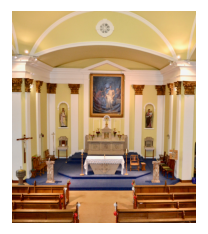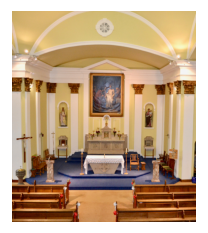
© Lorem ipsum dolor sit Nulla in mollit pariatur in, est ut dolor eu eiusmod lorem 2013
Following
the
Second
Vatican
Council,
a
certain
amount
of
alteration
was
required
to
accommodate
the
new
Liturgy.
The
altar
rails
and
pulpit
were
removed,
and
the
sanctuary
was
extended.
A
new
altar
of
Hopeman
stone
was
designed
and
carved
by
parishioner
Liam
Barr.
He
also
constructed
two
lecterns
from
the
alabaster,
salvaged
from
the
rails and the pulpit.
In
1988
dry-rot
was
discovered,
requiring
immediate
remedial
action,
but
in
1995
a
substantial
incentive
to
undertake
a
major
restoration
was
given,
with
the
award
of
grants
by
Historic
Scotland,
together
with
a
loan
from
the
Diocese
of
Aberdeen.
Work
on
this
historic
Grade
1
Listed
Building
commenced
in
March
1996,
and
the
bulk
of
it
was
completed
by
December
of
that
year.
Supervising
architects
were
the
Oliver
Humphries
Partnership,
and the work was executed by contractors Hall and Tawse, Aberdeen.
This
is
a
brief
history
of
our
beautiful
church.
It
is
a
story
of
vision,
faith,
and
enthusiasm,
which
has
led
to success.
History of St Thomas Church - Part Five




© Lorem ipsum dolor sit Nulla in mollit pariatur in, est ut dolor
eu eiusmod lorem 2013
History of
St Thomas Church Part Five
Following
Vatican
2,
a
certain
amount
of
alteration
was
required
to
accommodate
the
new
Liturgy.
The
altar
rails
and
pulpit
were
removed,
and
the
sanctuary
was
extended.
A
new
altar
of
Hopeman
stone
was
designed
and
carved
by
parishioner
Liam
Barr.
He
also
constructed
two
lecterns
from
the
alabaster,
salvaged from the rails and the pulpit.
In
1988
dry-rot
was
discovered,
requiring
immediate
remedial
action,
but
in
1995
a
substantial
incentive
to
undertake
a
major
restoration
was
given,
with
the
award
of
grants
by
Historic
Scotland,
together
with
a
loan
from
the
Diocese
of
Aberdeen.
Work
on
this
historic
Grade
1
Listed
Building
commenced
in
March
1996,
and
the
bulk
of
it
was
completed
by
December
of
that
year.
Supervising
architects
were
the
Oliver
Humphries
Partnership,
and
the
work
was
executed
by
contractors
Hall
and
Tawse, Aberdeen.
This
is
a
brief
history
of
our
beautiful
church.
It
is
a
story
of
vision, faith, and enthusiasm, which has led to success
.






















